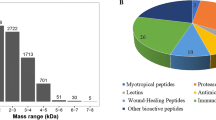Abstract
High-resolution mass spectrometry-based peptidomics has been used to characterize several components in electro-stimulated skin secretions of the endemic Mexican frog Pachymedusa dacnicolor. Peptide mass screening performed in an Orbitrap-XL mass spectrometer showed that P. dacnicolor skin secretions possess 194 different components with molecular masses ranging mainly from 500 to 6,000 Da. Dozens of molecules were partially sequenced including two novel protease inhibitors. Additionally, one posttranslationally modified bradykinin and two novel dermaseptin-like antimicrobial peptides were fully sequenced. The novel peptide named here DMS-DA5 was fully characterized and showed potent antibacterial activity against various bacteria such as Escherichia coli, Bacillus subtilis, Salmonella enterica serovar typhimurium, and Pseudomonas aeruginosa with minimal inhibitory concentrations from 3.10 to 25.0 μM.





Similar content being viewed by others
References
Amiche M, Ladram A, Nicolas P (2008) A consistent nomenclature of antimicrobial peptides isolated from frogs of the subfamily Phyllomedusinae. Peptides 29(11):2074–2082
Armirotti A, Scapolla C, Benatti U, Damonte G (2007) Electrospray ionization ion trap multiple-stage mass spectrometric fragmentation pathways of leucine and isoleucine: an ab initio computational study. Rapid Commun Mass Spectrom 21(19):3180–3184
Auvynet C, Joanne P, Bourdais J, Nicolas P, Lacombe C, Rosenstein Y (2009) Dermaseptin DA4, although closely related to dermaseptin B2, presents chemotactic and Gram-negative selective bactericidal activities. FEBS J 276(22):6773–6786
Batista CV, da Silva LR, Sebben A, Scaloni A, Ferrara L, Paiva GR, Olamendi-Portugal T, Possani LD, Bloch C Jr (1999) Antimicrobial peptides from the Brazilian frog Phyllomedusa distincta. Peptides 20(6):679–686
Batista CV, D’Suze G, Gómez-Lagunas F, Zamudio FZ, Encarnación S, Sevcik C, Possani LD (2006) Proteomic analysis of Tityus discrepans scorpion venom and amino acid sequence of novel toxins. Proteomics 6(12):3718–3727
Batista CV, Román-González SA, Salas-Castillo SP, Zamudio FZ, Gómez-Lagunas F, Possani LD (2007) Proteomic analysis of the venom from the scorpion Tityus stigmurus: biochemical and physiological comparison with other Tityus species. Comp Biochem Physiol C Toxicol 146(1–2):147–157
Chen T, Orr DF, O’Rourke M, McLynn C, Bjourson AJ, McClean S, Hirst D, Rao P, Shaw C (2004) Pachymedusa dacnicolor tryptophyllin-1: structural characterization, pharmacological activity and cloning of precursor cDNA. Regul Pept 117(1):25–32
Conlon JM (2004) The therapeutic potential of antimicrobial peptides from frog skin. Rev Med Micro 15:17–25
Conlon JM, Iwamuro S, King JD (2009) Dermal cytolytic peptides and the system of innate immunity in anurans. Ann N Y Acad Sci 1163:75–82
Frost, DR (2009) Amphibian species of the world: an online reference. Version 5.3. Electronic database accessible at http://research.amnh.org/vz/herpetology/amphibia/index.php, American Museum of Natural History, New York, USA
Gottler LM, Ramamoorthy A (2009) Structure, membrane orientation, mechanism, and function of pexiganan—a highly potent antimicrobial peptide designed from magainin. Biochim Biophys Acta 1788(8):1680–1686
Hancock RE, Lehrer R (1998) Cationic peptides: a new source of antibiotics. Trends Biotechnol 16:82–88
Mahalka AK, Kinnunen P (2009) Binding of amphipathic α-helical antimicrobial peptides to lipid membranes: lessons from temporins B and L. Biochim Biophys Acta 1788:1600–1609
National Committee for Clinical Laboratory Standards (1997) Methods for dilution antimicrobial susceptibility tests for bacteria that grow, aerobically, approved standard M7-A4. NCCLS, Wayne, PA
Nicolas P, El Amri C (2009) The dermaseptin superfamily: a gene-based combinatorial library of antimicrobial peptides. Biochim Biophys Acta 1788:1537–1550
Nicolas P, Rosenstein Y (2009) Multifunctional host defense peptides. FEBS J 276(22):6464
Olamendi-Portugal T, Batista CV, Restano-Cassulini R, Pando V, Villa-Hernandez O, Zavaleta-Martínez-Vargas A, Salas-Arruz MC, Rodríguez de la Vega RC, Becerril B, Possani LD (2008) Proteomic analysis of the venom from the fish eating coral snake Micrurus surinamensis: novel toxins, their function and phylogeny. Proteomics 8(9):1919–1932
Rydlo T, Rotem S, Mor A (2006) Antibacterial properties of dermaseptin S4 derivatives under extreme incubation conditions. Antimicrob Agents Chemother 50(2):490–497
Shai Y (1999) Mechanism of the binding, insertion and destabilization of phospholipids bilayer membranes by alpha-helical antimicrobial and cell non-selective membrane-lytic peptides. Biochim Biophys Acta 1462:55–70
Thompson AH, Bjourson AJ, Orr DF, Shaw C, McClean S (2007) Amphibian skin secretomics: application of parallel quadrupole time-of-flight mass spectrometry and peptide precursor cDNA cloning to rapidly characterize the skin secretory peptidome of Phyllomedusa hypochondrialis azurea: discovery of a novel peptide family, the hyposins. J Proteome Res 6(9):3604–3613
Wang L, Zhou M, Chen T, Walker B, Shaw C (2009) PdT-2: a novel myotropic type-2 tryptophyllin from the skin secretion of the Mexican giant leaf frog, Pachymedusa dacnicolor. Peptides 30(8):1557–1561
Wang M, Wang Y, Wang A, Song Y, Ma D, Yang H, Ma Y, Lai R (2010) Five novel antimicrobial peptides from skin secretions of the frog, Amolops loloensis. Comp Biochem Physiol B Biochem Mol Biol 155(1):72–76
Wechselberger C (1998) Cloning of cDNAs encoding new peptides of the dermaseptin family. Biochim Biophys Acta 1388:279–283
Zairi A, Tangy F, Bouassida K, Hani K (2009) Dermaseptins and magainins: antimicrobial peptides from frogs’ skin-new sources for a promising spermicides microbicides—a mini review. J Biomed Biotechnol 2009:452–567 PMID: 19893636 [PubMed-in process]
Acknowledgments
This research was supported by grant from the Dirección General de Asuntos del Personal Académico (DGAPA) of the National Autonomous University of Mexico-UNAM (Grant number IN221508 to CVFB).
Author information
Authors and Affiliations
Corresponding author
Rights and permissions
About this article
Cite this article
Meneses, E.P., Villa-Hernández, O., Hernández-Orihuela, L. et al. Peptidomic analysis of the skin secretions of the frog Pachymedusa dacnicolor . Amino Acids 40, 113–122 (2011). https://doi.org/10.1007/s00726-010-0564-9
Received:
Accepted:
Published:
Issue Date:
DOI: https://doi.org/10.1007/s00726-010-0564-9




